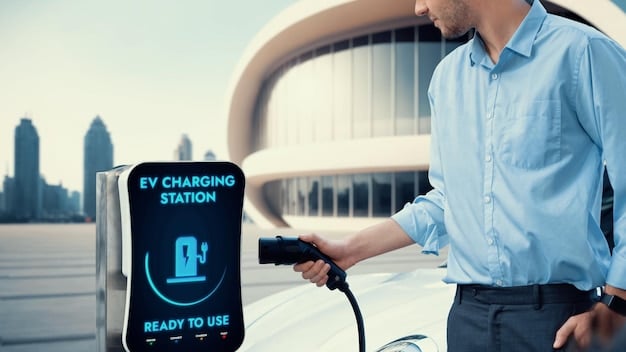Electric Vehicle Market Share Reaches Record 12% in US – Report

A recent Electric Vehicle Market Share Report reveals that electric vehicles (EVs) now account for a record 12% of all new car sales in the US, signaling a significant shift in consumer preferences and the automotive industry landscape.
The automotive industry is undergoing a significant transformation, and the latest Electric Vehicle Market Share Report underscores this shift. Electric vehicles (EVs) have reached a new milestone, capturing a record 12% of all new car sales in the US. This surge indicates growing consumer confidence and acceptance of electric mobility.
Electric Vehicle Adoption Soars to New Heights
The recent surge in electric vehicle (EV) market share to 12% marks a pivotal moment for the automotive industry in the United States. This milestone illustrates the growing consumer interest in sustainable transportation options and reflects the impact of advancements in EV technology and infrastructure.
Key Factors Driving EV Adoption
Several factors have contributed to the rise in EV market share. Increased awareness of environmental concerns, coupled with government incentives and tax credits, has made EVs a more attractive option for many consumers.
- Government Incentives: Federal and state incentives reduce the upfront cost of purchasing an EV.
- Improved Technology: Advancements in battery technology have increased the range and performance of EVs.
- Growing Charging Infrastructure: The expansion of public charging networks makes it easier for EV owners to charge their vehicles.
Additionally, the increasing number of EV models available from various manufacturers has provided consumers with more choices, catering to different preferences and needs.

Ultimately, the combination of these factors has created a favorable environment for EV adoption, driving the market share to unprecedented levels.
Understanding the Electric Vehicle Market Share Report
The Electric Vehicle Market Share Report provides valuable insights into the performance and trends of the EV market. This report offers a comprehensive analysis of sales data, consumer preferences, and market dynamics.
Key Findings from the Report
The report highlights several key findings, including the significant increase in EV sales, the growing market share of EVs compared to traditional gasoline-powered vehicles, and the regional variations in EV adoption rates.
- Sales Growth: EV sales have increased substantially year-over-year, reflecting growing consumer demand.
- Market Share: EVs now represent a significant portion of overall new car sales in the US.
- Regional Differences: EV adoption rates vary across different states, with California leading the way.
Furthermore, the report analyzes the factors driving EV adoption, such as government incentives, technological advancements, and infrastructure development. Understanding these findings is crucial for automakers, policymakers, and industry stakeholders.
By examining the data and trends presented in the report, stakeholders can make informed decisions and develop strategies to support the continued growth of the EV market.
Regional Variations in Electric Vehicle Adoption
While electric vehicle adoption is on the rise across the United States, there are significant regional variations in the rate at which EVs are being embraced. Certain states and metropolitan areas are leading the charge, while others lag behind.

California, for example, has consistently been at the forefront of EV adoption, thanks to its supportive policies, extensive charging infrastructure, and environmentally conscious population. Other states, such as Washington and Oregon, have also seen strong EV growth, driven by similar factors.
Factors Influencing Regional Adoption
Several factors contribute to these regional differences. Government incentives, such as tax credits and rebates, play a crucial role in making EVs more affordable and attractive to consumers. The availability of charging infrastructure is another critical factor, as EV owners need convenient and reliable access to charging stations.
- State Policies: States with strong environmental policies and incentives tend to have higher EV adoption rates.
- Charging Infrastructure: The density of public charging stations influences consumer confidence in EVs.
- Consumer Awareness: Public awareness and education campaigns can promote EV adoption.
Additionally, local economic conditions, consumer preferences, and the availability of EV models can also impact adoption rates. Understanding these regional dynamics is essential for tailoring policies and strategies to promote EV adoption effectively.
In conclusion, while EV adoption is a national trend, it is important to recognize and address the regional variations that exist across the United States.
The Role of Government Incentives and Policies
Government incentives and policies play a pivotal role in driving the adoption of electric vehicles. These initiatives are designed to reduce the upfront cost of purchasing an EV, encourage the development of charging infrastructure, and promote public awareness of the benefits of electric mobility.
Federal Tax Credits
The federal government offers tax credits to consumers who purchase eligible EVs. These tax credits can significantly lower the cost of EV ownership, making them more accessible to a wider range of buyers. The value of the tax credit varies depending on the vehicle’s battery capacity and other factors.
In addition to federal tax credits, many states offer their own incentives, such as rebates, tax credits, and grants. These state-level incentives can further reduce the cost of EV ownership and encourage adoption.
Furthermore, governments can support the development of charging infrastructure by providing grants and incentives to companies and organizations that install public charging stations. This helps to alleviate range anxiety and make EV ownership more convenient.
Overall, government incentives and policies are crucial for accelerating the adoption of electric vehicles and promoting a cleaner, more sustainable transportation system.
Advancements in Electric Vehicle Technology
The electric vehicle industry is characterized by rapid technological advancements that are continually improving the performance, range, and affordability of EVs. These advancements are key drivers of the increasing market share of electric vehicles in the United States.
Battery Technology
One of the most significant areas of advancement is battery technology. Recent breakthroughs have led to batteries with higher energy density, allowing EVs to travel longer distances on a single charge. Additionally, battery costs have been declining, making EVs more affordable for consumers.
- Increased Range: New battery technologies are extending the range of EVs, reducing range anxiety.
- Lower Costs: Declining battery costs are making EVs more competitive with gasoline-powered vehicles.
- Faster Charging: Advancements in charging technology are reducing the time it takes to recharge an EV.
Furthermore, innovations in motor technology, power electronics, and vehicle design are also contributing to the improved performance and efficiency of EVs. These advancements are making EVs a more attractive and practical option for a growing number of consumers.
As technology continues to evolve, we can expect to see further improvements in EV range, performance, and affordability, driving even greater adoption rates in the years to come.
Challenges and Opportunities in the Electric Vehicle Market
Despite the impressive growth in electric vehicle market share, several challenges and opportunities remain. Addressing these challenges and capitalizing on these opportunities is crucial for ensuring the continued success and expansion of the EV market.
Charging Infrastructure
One of the primary challenges is the need for more extensive and reliable charging infrastructure. While the number of public charging stations has been growing, it is still not sufficient to meet the needs of the increasing number of EV owners. Expanding the charging network, particularly in underserved areas, is essential for reducing range anxiety and encouraging EV adoption.
- Infrastructure Expansion: Investing in more public charging stations is crucial for supporting EV growth.
- Standardization: Establishing uniform charging standards can improve the user experience.
- Grid Capacity: Upgrading the electrical grid is necessary to handle the increased demand from EVs.
Moreover, there are opportunities to develop innovative charging solutions, such as wireless charging and battery swapping, which could further enhance the convenience and practicality of EV ownership.
In addition to infrastructure challenges, there are also opportunities to address issues such as supply chain bottlenecks, workforce development, and consumer education. By proactively tackling these challenges and seizing these opportunities, the electric vehicle market can achieve its full potential and contribute to a cleaner, more sustainable future.
| Key Point | Brief Description |
|---|---|
| 📈 Record Market Share | EVs account for 12% of new car sales in the US. |
| 💰 Government Incentives | Tax credits and rebates boost EV affordability. |
| 🔋 Battery Technology | Advancements increase range and lower costs. |
| ⚡ Charging Infrastructure | Expansion needed to support growing EV adoption. |
Frequently Asked Questions (FAQ)
What is the current EV market share in the US?
▼
Electric vehicles (EVs) now account for 12% of all new car sales in the United States, marking a new record.
▼
Electric vehicles (EVs) now account for 12% of all new car sales in the United States, marking a new record.
▼
California currently leads the US in electric vehicle adoption, driven by supportive policies and infrastructure.
▼
Key factors include government incentives, technological advancements, and growing charging infrastructure.
▼
Federal and state incentives reduce the upfront costs, making EVs more accessible to consumers.
▼
Challenges include expanding charging infrastructure and addressing supply chain bottlenecks.
Conclusion
The Electric Vehicle Market Share Report highlights a significant milestone in the automotive industry, with EVs now accounting for 12% of new car sales in the US. This growth is driven by various factors, including government incentives, technological advancements, and increasing consumer awareness. While challenges remain, the future looks promising for electric vehicles, signaling a shift towards a more sustainable transportation system.





